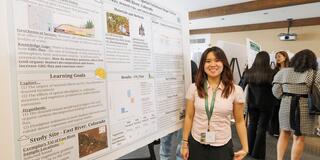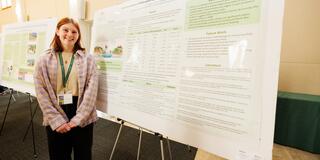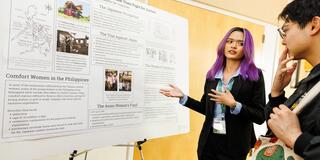
Students Improve the World With Their Research
USF students tackled climate change, water pollution, and more than 100 other challenges at Creative Activity and Research Day this month. They shared their work in posters, presentations, and projects.

Amber Le ’25, chemistry
“I studied floodplains of the East River, in Colorado, and learned that they produce more CO2 greenhouse gas in the dry season of August and September than in the wet season of May and June, when the floodplains are filled with snowmelt. The dryer the season, the higher the CO2 emissions — it leads to a vicious cycle of rising temperatures. This research highlights the vulnerability of floodplains to environmental shifts, and future research can build on these findings to develop land management strategies such as limiting soil disturbance and controlling growth of vegetation.”

Maribel Ybanez ’25, biology; Annette Lee MSEM ’26; Evan Eldermire MSEM ’26; Makena Gichuru ’25, environmental science; Allison Luengen, associate professor, environmental science; Elaina Herrmann MSEM ’25; Sarah Burton MSEM ’26 (Ilyah Lisensky MSEM ’25 not pictured)
“To see if fur is an accurate indicator of mercury in the body of a coyote, we compared the mercury concentration found in the kidneys of local coyotes to the mercury concentration found in the fur of those same coyotes. (We didn’t kill the coyotes. They died of natural causes.) We found that the tissue tests and the fur tests agreed. This means that researchers can test coyote fur for mercury and trust the results as scientifically valid. It’s easier to gather fur than it is to gather internal organs. By testing fur for mercury, we can determine if local coyotes are in any danger of mercury poisoning from eating sea lions, racoons, and other prey that might be high in mercury.”

Emily Wallace ’26, MS in environmental management (MSEM)
“Chemicals known as perfluoroalkyl substances or PFAs, commonly found in Teflon pans and rain jackets, are contaminants in San Francisco Bay. PFAs have been linked to endocrine disruption and neurotoxicity. PFAs move through the food chain. They’re first ingested by invertebrates, then fish, then predators like seals and birds. Concentrations are significantly greater in south San Francisco Bay because of industrialization and the lack of flushing. Harbor seal populations in the South Bay have not increased even though other populations along the California coast have, which may be partially attributed to PFA contamination. PFAs are also found in wastewater, sediments, and sport fish, which could be a concern for human health.”

Zayda De Guzman ’25, Asian studies
“I want to shine a light on Filipino ‘comfort women.’ During World War II, women in the Philippines were forced into sexual slavery by the occupying Japanese military. At the height of the war, more than 30 comfort stations dotted the country. Most of the women were in their teens, and some were girls. I’ve done research to keep their names alive and to tell their stories in the hopes that history won’t repeat itself.”


